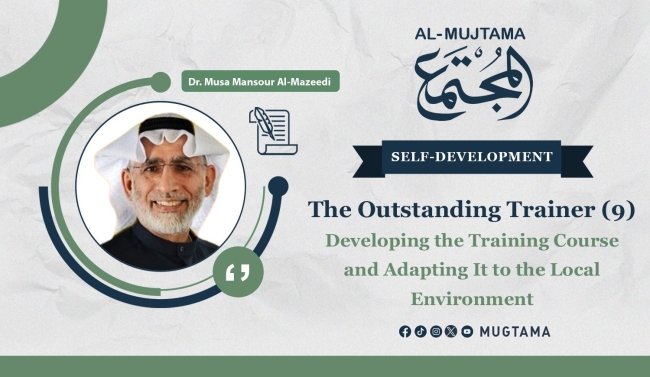The Outstanding Trainer (9) Developing the Training Course and Adapting It to the Local Environment
We had already presented four steps in our previous article on how to deliver slides for training courses. In this article, we will continue explaining those steps while providing a summary of the previous ones.
An outstanding trainer should allocate approximately two minutes for each slide in front of the trainees, which may slightly increase or decrease.
Example: If the training session lasts 3.5 hours (excluding breaks), the number of slides should be around 100. The trainer should also prepare 50 extra slides for backup, making a total of 150 slides for a 3.5-hour training session. Thus, a three-day training course would require about 450 slides.
The trainer must be aware that most training sessions average 4 hours, with a 30-minute break in between.
Example: During one training course at the Ibn Haytham Center, part of the Public Authority for Applied Education and Training, titled "How to Become a Charismatic and Attractive Personality?", the course lasted 5 days at a rate of 4 hours per day. I prepared about 750 slides for it, averaging 150 slides per day.
Slide Content
An outstanding trainer ensures the slides are diverse, captivating, visually comfortable, and easy to read. They avoid text overload and theoretical discourse, ensuring a smooth flow between slides.
Slides Should be Varied, Easy to Read, and Follow One Another in Harmony and Coherence
Here is a proposed layout and sequence for slide presentation:
- First slide: Displays the course title in large font (size 72), the institution's name, trainer's name, organizing body, and course date in smaller font (size 40), along with the institution's logo and an illustrative image related to the course.
- Introduction: After welcoming the attendees, present a slide with one to three short stories (3–5 minutes each) related to the course topic to engage the audience and allow latecomers to catch up.
- Self-introduction slide: The trainer introduces themselves briefly, highlighting key achievements, especially in training.
- Attendee introduction slide: Each participant shares their name, workplace, years of experience, and a positive word starting with the first letter of their name for added excitement.
- Detailed objectives: Present each objective on a separate slide.
- “Did you know?” slide: Provides brief statistics related to the course topic.
- Quiz slides: Include 20 questions to assess the participants’ prior knowledge, each question on a separate slide. These should be true/false or multiple-choice questions rather than open-ended ones.
At this point, the trainer calculates the participants' average pre-course knowledge, then repeats the quiz at the end to measure the knowledge gained.
- Start with the first objective: The trainer continues with a varied presentation style, alternating between questions, stories, individual and group exercises, videos, role-playing, brainstorming sessions, polls, and open discussions.
- Personal action plan slide: The course concludes with a personal action plan slide and a re-administration of the knowledge test to measure improvement. Any increase above 10% indicates the trainees benefited from the course. Based on previous experience, a well-designed course typically results in a 25% increase in knowledge.
- Evaluation: The trainees then evaluate the trainer’s performance, the course content, and the extent of its benefits.
Example: In one course for the Mumtazeen Foundation titled "Skills for Enhancing Efficiency and Increasing Achievements", participants answered 24 true/false questions at the beginning. Their average pre-course knowledge was 77%. By the end of the course, it reached 100%, indicating a 23% improvement—a highly acceptable result in the training field.
Fifth Step: Developing the Course and Adapting It to the Local Environment
An outstanding trainer learns from trainees' evaluations, constantly improving their skills and adapting course content to fit the local environment.
An Outstanding Trainer Benefits from Trainees' Feedback and Adapts the Course Content to Suit the Local Context
Examples:
- Oil Sector Course: For the Kuwait Chemical Industries Company, titled "How to Motivate Others at No Cost?", feedback suggested shortening the video presentations. Initially lasting 30 minutes, the videos were divided into three shorter segments of 5–10 minutes each, followed by a discussion.
- Kuwait Oil Tanker Company Course: Feedback highlighted the need to use local scenarios and practical examples relevant to the local environment, such as body language differences between Kuwaitis and international standards.
- Kuwait National Petroleum Company Course: Global statistics were adjusted to reflect local realities. For instance, the main fear factor in Western countries was public speaking, while in developing countries, financial difficulties ranked first.
- Guest Speaker Suggestion: For a course by Kuwait Oil Company, a suggestion was made to invite a prominent local figure. Engineer Issa Bouyabes, head of Kuwait’s oil well firefighting team, was invited to share valuable practical insights.
- Health Assurance Hospitals Company Course: Trainees requested a 15-minute discussion period at the end of the course. This became a standard practice for other organizations as well.
- Ministry of Higher Education Course: Trainees proposed changing the break location to a nearby café, which was implemented whenever feasible.
Thus, an outstanding trainer is always well-prepared, benefits from trainees’ evaluations, and adapts their courses to ensure they resonate with the local environment, making each session more engaging and impactful.
-------------------------------------------------------------


